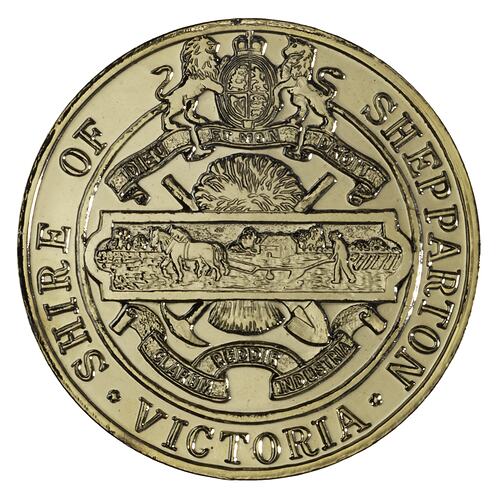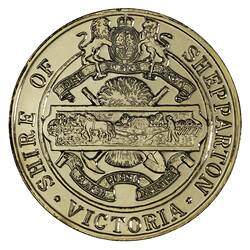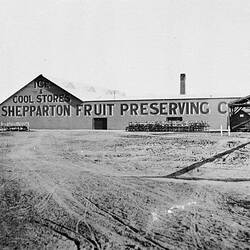Shepparton Shire Council was located 179 kilometres north of Melbourne. The Shire existed from 1884 until it became the centre of the Rural City of Shepparton in 1994.
The Pangerang people inhabited the Shepparton region until 1838, when Europeans began to settle the land. Sherbourne Sheppard took up Tallygaroopna station in 1843. By 1853 Paddy McGuire's Punt was a crossing place on the Goulburn River. The town that developed around the river crossing was at first called Shepparton (Sheppardtown)-on-McGuire's Punt, but its name was soon shortened. It was not until the late 1860s, however, that land in the region was selected under recently-enacted Victorian legislation.
John Hare Furphy moved to Shepparton in 1873. Establishing a metal foundry, he quickly discovered the need for water transport. Furphy invented the Furphy water cart: a metal tank on wheels. The Australian military took Furphys to Europe and Middle East during World War 1. The word 'Furphy' has passed into the language, meaning a rumour or false report. It appears to have been first used in about 1915 in Egypt where the drivers of water carts were given to spreading rumours in the camps.
Shepparton became a shire in 1884. By 1910 it had a population of more than 3000, supported by fruit and dairy industries. Irrigation was brought to the Shepparton side of the Goulburn in that year, encouraging and supporting closer settlement. Shepparton became a borough in 1927, celebrated its centenary in 1938 and was declared a city in 1949.
The Shepparton Shire Council issued a medal in 1985 to commemorate the sesquicentenary of Victoria (NU 20710).
The notion of Greater Shepparton was promoted by the former Shepparton and Rodney Councils at least as early as the mid 1960s to attract commercial investment to the region. On 18 November 1994 the Shire of Shepparton, City of Shepparton, part of Shires of Rodney, Euroa, Goulburn, Tungamah, Violet Town and the Shire of Waranga united to form the Greater Shepparton City Council.
Shepparton today has an Aboriginal Keeping Place which tells the story of the indigenous people of the region.
References:
People's Voice: Australian Community History Online website. Http://www.peoplesvoice.gov.au/stories/vic/shepparton/shepparton_c.htm
Australian Places website, Monash University http://arts.monash.edu/ncas/multimedia/gazetteer/list/greatershepparton.html; Municipal Association of Victoria web site http://www.mav.asn.au
Blake, L. (1977). Place Names of Victoria.
More Information
-
Keywords
-
Localities
-
Authors
-
Article types


